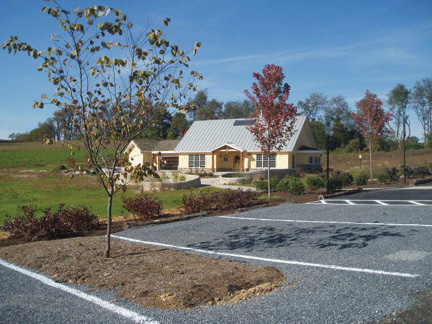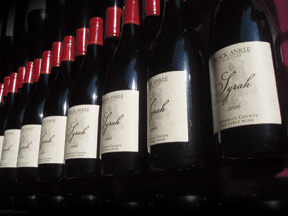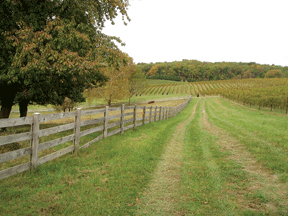
Class of ’85 and ’94 | “It really started with drinking wine,” says Ed Boyce C’85. “Before it got out of control.”
Specifically, it began with a bottle of 1979 Chateau Mouton-Rothschild. That vintage was hardly a stellar one, but there’s something about a first-growth Bordeaux that can drive some people to distraction. Ed Boyce was one such. A revelatory glass at Thanksgiving dinner sent the longtime management consultant daydreaming about another career, and before long the itch had spread to his wife, Sarah O’Herron C’94.
“We’d always loved wine,” she says, trying to pinpoint the moment when control officially went out the window. “And we’d always been kind of fascinated by what it took to make a great wine versus a not-so-good wine.”
So they resolved to find out firsthand. But there was a catch. Although O’Herron didn’t mind leaving her job—she was a consultant at the same firm—she didn’t want to leave home. And there was the rub. Boyce and O’Herron worked in the wrong Washington for winemaking. Their house was just north of the nation’s capital, in Silver Spring, Maryland.
So in 2001, undeterred and with soil maps in hand, they began driving around the patchwork of dairy farms and sub-developments west of Interstate 95, looking for a place to plant grapevines. A year later, with financial assistance from a state land-preservation program, they bought what would become Black Ankle Vineyards. It was a 146-acre farm in Frederick County planted in “typical Maryland field crops—corn, soybeans, and hay,” O’Herron says.

It would take the better part of a decade to coax a glass of wine from the 22 acres they planted. By the time Boyce and O’Herron pushed their first corks into bottles last April, their eldest child had gained four siblings. Fortunately, the family soon got a sign that mom and dad hadn’t gone completely mad. In September Black Ankle’s flagship red, Crumbling Rock—a Bordeaux-style blend of Cabernet Franc, Cabernet Sauvignon, Merlot, and Petit Verdot—was named Best in Show in the Maryland Governor’s Cup wine competition. The winery had not yet even opened for business.
“This wine represents a turning point for the Maryland wine industry,” declared Al Spoler, the competition’s organizer, on the weekly radio show he hosts on WYPR, Baltimore’s NPR affiliate. “This is one of the most serious wines I’ve tasted coming out of the East Coast.”
Historically, the East Coast’s challenging climate and rich array of grapevine pests have led many wineries to bypass European vitis vinifera varietals like Cabernet Sauvignon in favor of hardier French-American hybrids.
“We just don’t subscribe to that,” Boyce says. “The hybrid grapes—some of them can make a nice wine sometimes, but I’ve never had one I really loved. They’re easier to grow, they survive the winters better, and they don’t take as much care in the vineyards, so there are certain things about them that make them easier. I think what you give up for that is the potential to make something great.”
Since they were also committed to adhering as closely as possible to organic standards, that meant figuring out how to deal with Japanese beetles, grapevine root-borers, grape-berry moths, and a whole host of potential blights that don’t really trouble vintners in California’s arid wine valleys. At an even more basic level, it meant coping with Maryland’s more-than-ample rainfall, which can turn promising grapes into watered-down plonk.
After research trips up and down the Eastern and Western seaboards, as well as to France, Italy, and New Zealand, Boyce and O’Herron were convinced that they needed to look toward Europe rather than California for viable strategies.
“The major thing we did was that we planted 2,000 vines per acre,” Boyce says. “Most places around us have 500 or 600, or maybe 800, which is a California model for wide spacing and big vines. But here, a certain amount of water falls on an acre. The French and the Italians have learned that if you cram a whole bunch of vines in there, they compete for the water and get some water stress. It’s more expensive to plant that way, but you get better wine.”
What they planted was what they liked: the major Bordeaux varietals, a couple from the Rhone valley, and a pair of European white grapes that you don’t see much in the States, Albariño and Grüner Veltliner. Serious vinifera grapes, in other words—but Boyce and O’Herron aren’t above having a little fun with them. They blended the last two on that list, which come from Spain and Austria, respectively, together with Viognier, Chardonnay, and Muscat in the aptly titled Bedlam blend.

“We had these tiny quantities of each one and we just didn’t have anything small enough to hold them,” O’Herron explains. “We said, ‘We’re either going to throw this out because it’ll go bad, or we’ll throw it together and see what happens.’” To their surprise, they liked the result enough to do it on purpose the following season.
After taking the top honor in the Maryland competition, Boyce and O’Herron started distributing their wines in small lots to a few dozen stores and restaurants, primarily in Baltimore. They also finished a tasting room built largely from materials culled from the vineyard itself. The straw-bale walls were made from hay grown on their fields, framed with timber harvested from their forest, and plastered with clay dug from their ground.
“We’re not quite organic, but we want to be as close as we can be,” says O’Herron. “So we wanted to build a building that was very eco-friendly and kind of Green.”
“The kids had a good time,” Boyce adds. “Plastering with mud, stacking straw bales and stuff, they had a good time with that. Hopefully they’ll be more useful in the future. We’ll see.”
In the meantime, the pair can finally sit back and sip on a vintage of their own making. “We’ve been doing this since 2001,” O’Herron says, “and here we are in 2008, finally, with some wine in bottles.”
—T.P.

